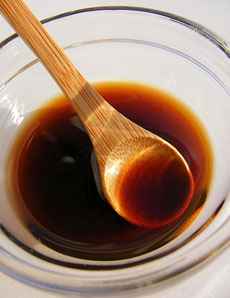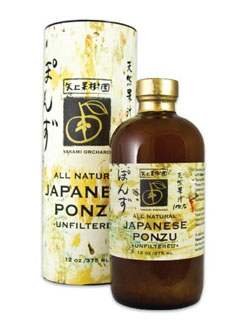TIP OF THE DAY: Ponzu Sauce Recipe & Uses
 Ponzu sauce (photo © Fotoos Van Robin | Flickriver). |
Following our recent endorsement of rice vinegar as an everyday condiment is this one for ponzu sauce. Ponzu is a thin, dark brown citrus-based sauce commonly used in Japanese cuisine. Often mixed with soy sauce (shoyu), it is a popular all-purpose condiment and dipping sauce. If you’ve ordered tempura in a Japanese restaurant, it was likely served with a small dish of ponzu. Ponzu sauce is traditionally made with rice vinegar, mirin (rice wine), katsuobushi (bonito tuna flakes) and konbu (seaweed). Some recipes use saké, a less sweet rice wine with a higher alcohol content. The ingredients are simmered and strained, and then citrus is added, typically yuzu, a bitter orange, or sudachi, a mandarin. (You can use lemon if you’re making it at home.) Mark Bittman of The New York Times calls it the rough equivalent of vinaigrette. |
|
|
Ponzu is an attractive condiment with both Western cuisine and its native Eastern cuisine. We recently substituted it for malt vinegar with French fries, and instead of mignonette sauce with oysters on the half shell. Here are more ways to enjoy ponzu sauce: |
||
|
RECIPE: HOMEMADE PONZU SAUCE
This recipe is adapted from Mark Bittman. It presumes you won’t have access to yuzu juice and uses commonly-available citrus. But in many cities, bottled yuzu juice (another of our favorite condiments) is readily available at specialty food stores and Asian markets. Ingredients For 2-1/2 Cups 1. COMBINE all ingredients in a bowl. Let sit for 2 hours or overnight to let flavors meld. 2. STRAIN before using. Refrigerated in an airtight container, ponzu will keep for at several days. |
 Yakami Orchard makes very high quality Ponzu. Nicely packaged, it makes a fine gift for a good cook. You can buy it online (photo © Yakami Orchard). |
|
|
PONZU VS. CHIRIZU SAUCE Chirizu is a spicier variation of ponzu, made with daikon, lemon juice, saké, scallions, soy sauce and shichimi togarashi, a table spice made of seven ingredients, including red pepper (togarishi) and sansho pepper pods (which provide heat). It can be served with stronger-flavored sashimi that hold up to the heat (mackerel instead of fluke, for example); as well as with fried fish. Here’s a recipe if you’d like to make your own. |
||


